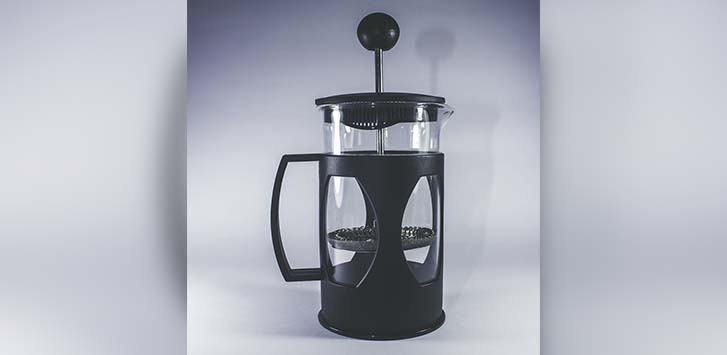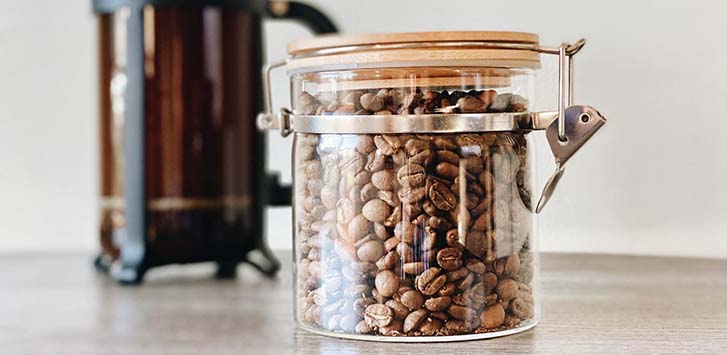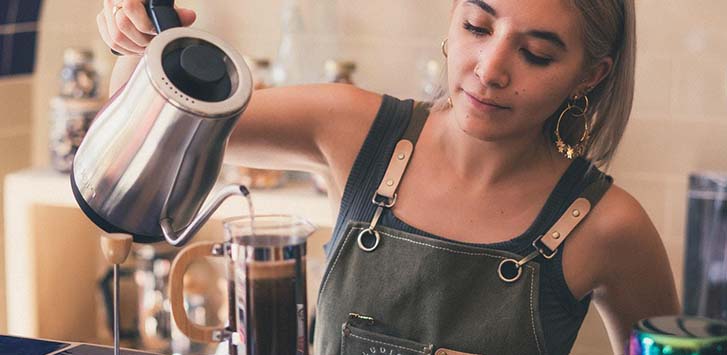
Looking for rich flavors in your everyday coffee without the hassle of complicated machines? Look no further than a French Press. The French Press is the golden ticket to your best cup of morning coffee.
This guide will take the guessing out of how to use a French Press coffee maker starting with some tips before you begin.
Tips for Using a French Press
Tip 1: Pick a Dark Roast or Full-Bodied Coffee Beans
This brewing method works best with bold flavors and intricate details to extract for a flavorful cup.
Tip 2: Use Coarse Grounds
Ideally a larger grind size is necessary for a perfect extraction and reduces the likelihood of grittiness in your drink. Using finer grounds may lead to overextraction, muddiness, or even problems with the plunger during pressing. To avoid bitter and gritty coffee, use uniformly coarse grounds.
Tip 3: Don't Use Boiling Water
Hot water is important to the brewing process of your French Press coffee, but using boiling water will over-extract your beans during the steeping process. A general temperature to shoot for would be about 200F (90C) which means just take your water off the kitchen stove before it begins to boil.
Tip 4: Find Your Favorite Coffee to Water Ratio
A good starting point is a 1:12 ratio which means using 30 grams of coffee for every 500 milliliters of water. This offers a balanced ratio with a strong flavor profile for your cup, without being overpowering. Once you are comfortable with the French Press process adjust as needed for a bolder or milder taste you desire.

How to Operate A French Press
With these four tips in mind, it is time to get started making your delicious coffee.
Step 1: Add Grounds and Heat Water
Heat your water just below boiling at about 200°F or 93°C. If you don’t have a thermometer, bring the water to almost boiling and let it sit for 30 seconds before pouring. Then, pour your coffee grounds into your French Press based on your preferred coffee to water ratio.
Step 2: Add Water
Pour the hot water over the grounds in a slow, circular motion to ensure even saturation. Once all the water is in, give the mixture a gentle stir. Be careful with the glass on your press while stirring to break up any dry areas and begin the extraction process.
Step 3: Allow Grounds to Bloom and Steep
With all the ground fully saturated, place the lid back onto the French Press with the plunger pulled all the way up. Do not press the plunger yet. Allow your coffee to steep for about 4 minutes before pressing. Not enough time for extraction will leave the taste weak and sour, but too much time causes bitterness.
Four minutes provides the perfect balance by allowing time to draw out the rich flavors while not over-extracting. For those learning how to use a French Press coffee maker for the first time, this is the actual brewing process of this method.
Step 4: Press Your Coffee
After four minutes, begin to slowly press the plunger down with steady and even pressure. Don’t rush this process to prevent scalding and spills. Your pressure should feel firm but move smoothly with minimal resistance. If you are finding it hard to press, your grind sizer may be too fine. To avoid any bitterness from over-extraction, pour your coffee right away.
Step 5: Serve in Your Favorite Mug and Enjoy!
After pressing all the way down with your French Press plunger, your coffee is ready to enjoy. Pour yourself a cup and pat yourself on the back because now you know how to use a French Press!
Take a moment to enjoy the aroma and body that the French Press brings out of your bold roast, but do not forget storing your leftovers. If you don’t plan on drinking your whole brew right away, it is a good idea to transfer the rest of the coffee immediately so it is not sitting in the press. Use a separate container, thermos, or mug for the remaining coffee so it does not over-extract and give you a bitter second cup.
Step 6: Clean Your French Press
Don’t forget to clean or wash your French Press after brewing to ensure that no grounds or oils are left behind for your next cup. Disassemble the pieces, discard the used grounds, and clean thoroughly to avoid bitterness in your future brews.

Conclusion
Of all the ways to make coffee, learning to use a French Press is an easy and rewarding task for every coffee lover to learn. The French Press is a convenient and very forgiving tool that brings sweet rewards. With a method this simple offering such a rich and full bodied cup, our days of automatic drip coffee are numbered. Take the time to experience operating a French Press which offers you the same conveniences for your everyday day cup for a better flavor.